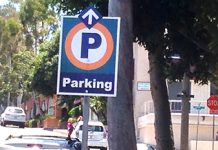Water quality regulators are pushing new rules that would likely prevent firework shows from occurring over areas like Hiesler Park. The San Diego Regional Water Quality Control Board, which oversees Laguna Beach, has issued a draft regulation to protect bodies of water like the Heisler Park marine reserve, designated as an area of special biological significance, so that discharges of any kind, including fireworks, would not be allowed.
At its regular meeting Tuesday the city council voted unanimously to seek an exemption from the regulation on the basis it holds only one show per year and would not pose significant harm to the ecosystem at Hiesler Park.
Incoming City Manager John Pietig said, “That’s a huge concern for us because Hiesler Park is a particularly good location (for the Fourth of July fireworks show) because it’s far enough away form the buildings, according to the professionals, and still at a point where it can be viewed well by the city. If the exception wasn’t granted it could be a huge issue.”
Facing a budget deficit last year, the city cut the popular July 4 show, but it was reinstated after a fundraiser was held by real estate broker Michael Gosselin. Additional expense could put this year’s show in jeopardy.
The exemption would only cover the city show; the private shows at Emerald Bay and Irvine Cove would need their own permits, which typically cost $1,452. Since they are not designated biologically significant, these areas are subject to less-stringent rules but still require clean up and water quality monitoring after fireworks.
Areas with Hiesler Park’s designation, “support an unusual variety of aquatic life, and often host unique individual species,” according to the state Water Resources Control Board, and require tighter limits on toxins than other areas.
Exemptions are unlikely according to Brian Kelley, a 25-year senior engineer with the San Diego Regional Water Quality Board. He said a show at Monument Point, “would probably be prohibited under this new order.”
Dave Schissler, director of water quality for Laguna Beach, agrees.
“I think we are either going to have to come up with a lot more money, and do something on a barge, or potentially relocate the launch point, or downsize the show or a combination of all those things,” he said.
Schissler added, “We don’t really know what the impacts are except that in all the years we have been testing the waters and doing studies of marine life, things are better than ever.”
As the regulation is still in draft form, with a workshop scheduled for Dec. 16 to take comment from stakeholders and the public, cities are still assessing the implications. Alex Roth, a spokesperson for San Diego Mayor Jerry Sanders said, “We are intensely scrutinizing all our options. We are going to be doing everything possible to make sure the people of La Jolla enjoy the same fireworks they have been enjoying for the past few decades.”
La Jolla is similar to Laguna in that it discharges its July 4 fireworks over a biologically sensitive area: La Jolla marine conservation area.
Dana Point city Manager Douglas Chotkevys said he is still “getting up to speed” on the proposal. San Clemente officials and Irvine Cove’s Association Director Jim Shubsda could not be reached. John Fox, Executive Director of the Emerald Bay Service District, would not take calls.
Pyro Spectaculars, the company that produces Laguna’s July 4 show, the Macy’s July 4 Show in New York City, and Irvine Cove’s show, among 400 others, is grappling with the potential effects on its business. Gary Brown, general counsel for the firm, said, “Of course it will impact our business. (San Diego) is the only jurisdiction in the country that interprets (the Clean Water Act) to apply to fireworks. It has taken us by surprise and we are trying to understand the reasons why and cooperate and come to a reasonable form of regulation. ”
The new regulations stem from a dispute between Sea World, which has discharged fireworks over San Diego Bay many times per year for over 20 years, and environmental groups that have sued to stop the shows. Sea World has had a permit to discharge into San Diego Bay since 2001, and has monitored water and sediment quality there for 10 years. Dave Koontz, Communications Director for Sea World asserts there is no evidence of adverse effects from fireworks.
“We have a permit for 150 (shows) per year and end up doing 110 to 120. After every fireworks show we do a water sweep of the area surrounding the barge and the following morning we do a sweep of the beach area at the northern side of the park as well as Fiesta Island in the middle of the bay,” he said.
The Regional Water Quality Control Board reports acceptable levels of toxins were found in the water, with the exception of zinc, bis (2-ethylhexyl) phthalate and perchlorate. Sediment is more problematic however: “Monitoring results show higher levels of pollutants associated with fireworks events within the sediment in the fireworks deposition zone, particularly for barium, chromium, cobalt, copper, silver and titanium. Results from short-term survival sediment toxicity sampling were highly variable…and range from non-toxic to highly toxic, making it difficult to detect any difference in short term toxicity.”




